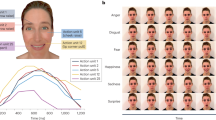Abstract
Whether recognition of emotion from facial expression is affected by distortions of pictorial quality has rarely been tested, with the exception of the influence of picture size on emotion recognition. On the other hand, this question is important for (low-cost) tele-communication and tele-conferencing. Here an attempt is made to study whether emotion recognition from facial expression is impaired when video stimuli are distorted both with respect to spatial (pixel) resolution and with respect to temporal resolution (refreshment rate).N=56 stimuli, in which professional actors encoded 14 different emotions, were presented to groups of judges (N=10 in each condition) in six different distortion conditions. Furthermore, judges were confronted with a control condition, presenting the non-distorted stimuli. Channel of information (close-up of the face versus full body recording) was in addition manipulated. Results indicate (besides main effects for type of emotion encoded and for channel) that emotion recognition is impaired by reductions of both spatial resolution and temporal resolution, but that even very low spatial and temporal resolutions result in recognition rates which are still considerably above chance expectation. Results are discussed with respect to the importance of facial expression and body movement in communicating emotions, and with respect to applied aspects concerning tele-communication.
Similar content being viewed by others
References
Bassili, J.N. (1979). Emotion recognition: The role of facial movement and the relative importance of upper and lower areas of the face.Journal of Personality and Social Psychology, 37 2049–2058.
Berry, D.S., Kean, K.J., Misovich, S.J., & Baron, R.M. (1991). Quantized displays of human movement: A methodological alternative to the point-light display.Journal of Nonverbal Behavior, 15 81–97.
Bradshaw, J.L. (1969). The information conveyed by varying the dimensions of features in human outline faces.Perception and Psychophysics, 6 5–9.
Bruce, V. (1988).Recognising faces. Hillsdale, NJ: Erlbaum.
Buck, R. (1988). The perception of facial expression: Individual regulation and social coordination. In T.R. Alley (Ed.),Social and applied aspects of perceiving faces (pp. 141–165). Hillsdale, NJ: Erlbaum.
Burgess, A.E., Wagner, R.F., Jennings, R.J., & Barlow, H.B. (1981). Efficiency of human visual signal detection.Science, 214 93–94.
Ekman, P. (1984). Expression and the nature of emotion. In K.R. Scherer & P. Ekman (Eds.),Approaches to emotion (pp. 319–344). Hillsdale, NJ: Erlbaum.
Ekman, P., & Friesen, W.V. (1974). Detecting deception from the body or face.Journal of Personality and Social Psychology, 29 288–298.
Ekman, P., & Friesen, W.V. (1976).Pictures of facial affect. Palo Alto, CA: Consulting Psychologists Press.
Ekman, P., Brattesani, K.A., O'Sullivan, M., & Friesen, W.V. (1979). Does image size affect judgments of the face?Journal of Nonverbal Behavior, 4 57–61.
Hager, J., & Ekman, P. (1979). Long distance transmission of facial affect signals.Ethology and Sociobiology, 1 77–82.
Haig, N.D. (1986). High resolution facial feature saliency mapping.Perception, 15 373–386.
Hall, E.T. (1968). Proxemics.Current Anthropology, 9 83–108.
Harmon, L.D. (1973). The recognition of faces.Scientific American, 229 71–82.
Harmon, L.D., & Julez, B. (1973). Masking in visual recognition: Effects of two-dimensional filtered noise.Science, 180 1194–1197.
James, W. (1932). A study of the expression of bodily posture.Journal of General Psychology, 7 405–436.
Leyhausen, P. (1967). Biologie von Ausdruck und Eindruck (Teil 1).Psychologische Forschung, 31 113–176.
MacKelvie, S.J. (1973). The meaningfulness and meaning of schematic faces.Perception and Psychophysics, 14 343–348.
Riskind, J.H. (1984). The stoop to conquer: Guiding and self-regulatory functions of physical posture after success and failure.Journal of Personality and Social Psychology, 47 479–493.
Scherer, K.R. (1986). Vocal affect expression: A review and a model for future research.Psychological Bulletin, 99 143–165.
Scherer, K.R., Banse, R., Wallbott, H.G., & Goldbeck, T. (1991). Vocal cues in emotion encoding and decoding.Motivation and Emotion, 15 123–148.
Scherer, K.R., Wallbott, H.G., & Summerfield, A.B. (Eds.). (1986).Experiencing emotion: A cross-cultural study. Cambridge: Cambridge University Press.
Tieger, T., & Ganz, L. (1979). Recognition of faces in the presence of two-dimensional sinusoidal masks.Perception and Psychophysics, 26 163–167.
Wallbott, H.G. (1991). The robustness of communication of emotion via facial expression: Emotion recognition from photographs with deteriorated pictorial quality.European Journal of Social Psychology, 21 89–98.
Wallbott, H.G., & Scherer, K.R. (1986). Cues and channels in emotion recognition.Journal of Personality and Social Psychology, 51 690–699.
Weisfled, G.E., & Beresford, J.M. (1982). Erectness of posture as an indicator of dominance or success in humans.Motivation and Emotion, 6 113–131.
Author information
Authors and Affiliations
Rights and permissions
About this article
Cite this article
Wallbott, H.G. Effects of distortion of spatial and temporal resolution of video stimuli on emotion attributions. J Nonverbal Behav 16, 5–20 (1992). https://doi.org/10.1007/BF00986876
Issue Date:
DOI: https://doi.org/10.1007/BF00986876




